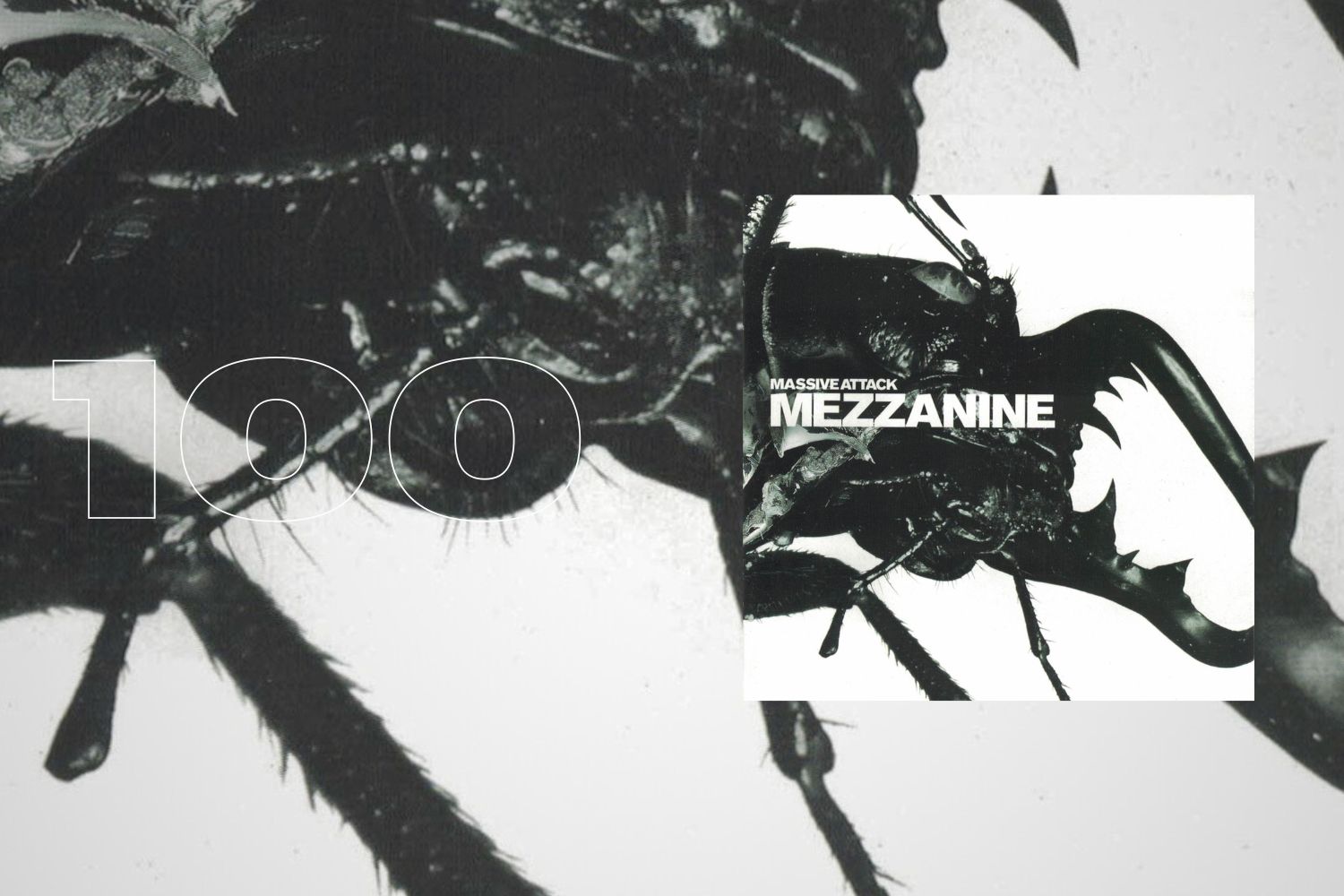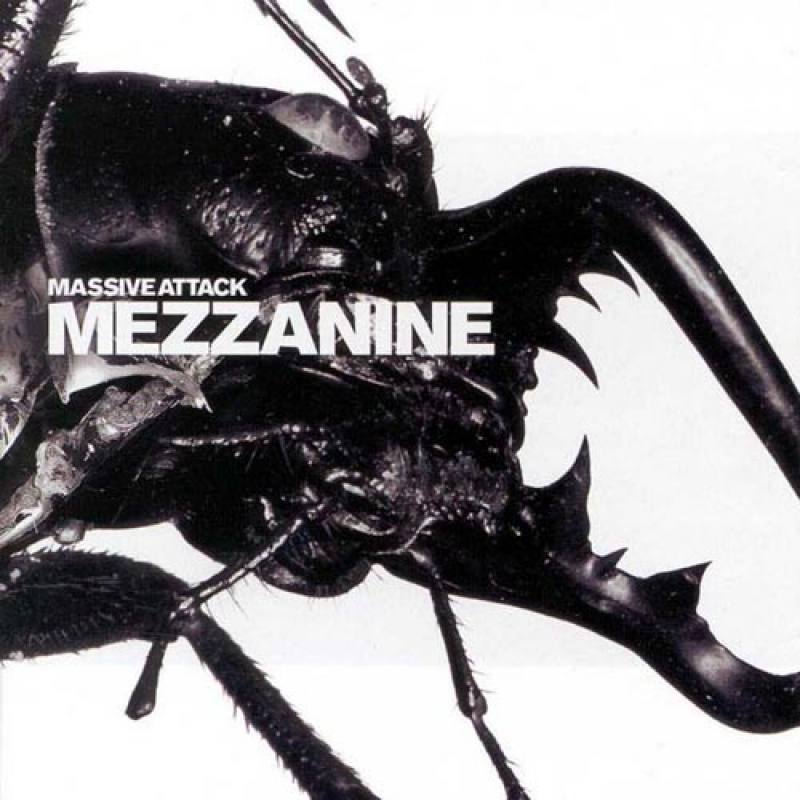Let’s start with some real talk: how could this album, of all albums, not end up on this retrospective list? Your friendly neighborhood music site has spent a good chunk of its life holding other releases up to the light of this one. Treble has also acknowledged it as a signpost of the Bristol music scene, an essential release for electronic music writ large and the trip-hop genre specifically, one of the best albums of 1998 and the 1990s altogether, and home to one of that decade’s best singles. To put a fine point on it, it’s got a funky beat, and you can bug out to it. Twenty-five years with all of this familiarity, and yet somehow Massive Attack’s Mezzanine stands sonically so far apart from the movements that birthed it as to be positively monolithic. It continues to beg to be scrutinized.
Getting in on trip-hop’s ground floor in the early 1990s meant labels like Mo’Wax and Ninja Tune, the first singles and LPs by the likes of Portishead, DJ Shadow, and Bjork solo, but especially Massive Attack’s Blue Lines in 1991. The quartet of Daddy G, Robert “3D” Del Naja, Tricky, and Andrew “Mushroom” Vowles had spun off from The Wild Bunch, a popular Bristol sound system. The group was given time and space to make actual music thanks to talented friends and contemporaries like Neneh Cherry, Smith & Mighty, and Soul II Soul’s Nellee Hooper. Their debut album fused rap, soul, and dub into something uniquely cool, a musical genetic experiment gone massively (!) right.
As for me, I got in on the second floor via the attached parking garage. In 1994 a copy of Massive Attack’s sophomore album, Protection, landed in my lap at our college newspaper office. I’d missed their debut, and so came to this music context-free. Even with Tricky gone to explore a solo career, Protection was unlike anything I’d heard before, one of the sexiest, most supple albums I’d yet encountered: yearning, dramatic, dangerous. So profoundly affecting was it that I wouldn’t feel the same kind of emotional weight on hearing Blue Lines for the first time, despite that LP’s historical importance, and I wouldn’t hear another album so associated with rain-soaked alleys and missed connections until Burial’s Untrue more than 13 years later. At this time, I was unnaturally curious about what Massive Attack would do next.
Blue Lines, full of obvious samples and raps, was as close to a hip-hop album as Massive Attack might muster. Protection flipped the script by painting with the colors of dub and reggae, later saturated by the remix skills of Mad Professor. But Mezzanine would flip it again in 1998, a pivotal year especially for electronic music that ran quieter and/or moodier than the mean. Yes, Madonna and Fatboy Slim began to power parties here and would continue for years to follow, but this was also a watershed moment for the likes of Air, Boards of Canada, Amon Tobin, Faithless, and UNKLE. In that vein, Mezzanine dropped most of Massive Attack’s pretense of a good time whether in the streets or in the sheets, adding wobbly guitars to a digitized facsimile of brooding modern rock.
After the bar had been set for the trip-hop genre, a long parade of pretenders and imitators attempted to clear it. So many merely downshifted to downtempo or just added in rote elements of jazz, acid or otherwise, yet expected to rise above the level of background music. These broadened the form to be sure, but also diluted its energy. In this landscape, and against a historical backdrop including the birth of Dolly the cloned sheep and the death of Princess Diana, 3D regrouped Massive Attack in order to kill what they loved.
Going thematically and sonically dark was not a unanimous decision. Vowles’ disagreements intensified the Mezzanine sessions: He was overruled on inviting past collaborator Madonna to sing on “Teardrop” instead of Cocteau Twins’ Elizabeth Fraser, for example, and protested the loudest against leaving their Black music influences behind in favor of sampling the likes of Lou Reed and Siouxsie Sioux. For what it’s worth, Massive Attack didn’t forsake all of their funk here. The “Exchange” interlude and coda on Mezzanine each ride the same Isaac Hayes sample. “Dissolved Girl” features the muted diva stylings of Sarah Jay Hawley, even as they rest atop a collection of guitar loops ranging from descending plucks to near-metal riffage. This song leads directly into a desperate cover of The Paragons’ “Man Next Door” featuring reggae veteran Horace Andy, at this point a de facto band member.
Yet that diptych of boom-bap balladry about fleeting relationships (“Fade, made to fade/Passion’s overrated anyway”) and mistrust in your fellow humans (“I’ve got to take my family/And find a quiet place”) was emblematic of the transition between Massive Attack old and new. The album hardly resembles the band that Mushroom first joined, mostly shrouded in atmospheres long associated with post-punk and particularly its goth and industrial offshoots. He would leave the band for good after this LP’s release.
The creative differences adopted for Mezzanine pushed to intoxicating levels the whiff of danger already present on the band’s first two LPs. “Inertia Creeps” finds 3D half-whispering over raindrop-tapped drums and clips of Turkish music, a soundtrack of international intrigue in search of a film. Massive Attack’s sublime track record with female guests continued with Fraser, a wraith navigating “Black Milk” and lifting up “Teardrop” to a peak of positivity ideal for media placements. The title track is full of loops and raps that trend tuneless and dissonant, one of a number of headphone trips where you’ll suddenly find yourself head-nodding in defiance of all logic.
If there’s a single song from the tracklist we can label as a microcosm of the album, of Massive Attack’s metamorphosis from beacons in the darkness to more dispassionate lurkers, it’s probably “Risingson.” The synths chatter and groan, the bass lines bubble, disembodied voices and digital winds envelop listeners as if opening the Ark of the Covenant. Over and through it all, the musicians trade verses about the kind of party they want, an avatar for the band’s conflicts during recording, but they also address the relentlessness and inevitability of partying anyway. “Automatic crystal remote control/They come to move your soul”—Massive Attack suggest you’ll dance to anything with their name on it, even if the groove takes you past the edge of the abyss.
The beautiful noise of Mezzanine veered away from Massive Attack’s soul and house origins; it more accurately parallels the work of Tackhead, the weird and wonderful late-1980s project from Adrian Sherwood that merged industrial and dub into agit-pop. Instead of paranoid sampledelics, however, Massive Attack’s unique songcraft relied on suffocating bass and an air of poignancy. Mezzanine would forever brand the band’s place in trip-hop as far more sinister and aggressive than the norm they’d helped to create.
Note: When you buy something through our affiliate links, Treble receives a commission. All albums we cover are chosen by our editors and contributors.
Treble is supported by its patrons. Become a member of our Patreon, get access to subscriber benefits, and help an independent media outlet continue delivering articles like these.



